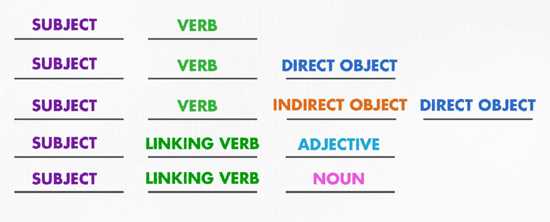Introduction to Units about Sentences
A sentence is the basic unit of written communication.
Sentences have all of the following required parts:
- Subjects
- verbs
- details that form a complete thought and that can stand-
alone
Sentences are also called independent clauses because they make sense by themselves, without other information.
The next set of units addresses common problems with sentences. Before learning more about the problems, review the parts of sentences and the common sentence patterns.
WATCH EXAMPLES
The video will show the common patterns for sentences. In each example, subjects appear in purple and verbs in green.
Download transcript.
READ EXAMPLES
All grammatical sentences consist of two parts:
- Subject
- Verb and details, which is called the predicate
No matter how long or complicated a sentence is, it is easy to break it into the subject and predicate parts by identifying the subject. The subject of a sentence is always a noun or another structure that acts as a noun. Everything else is part of the predicate.
Consider this complicated word group:
Finding out how much the payments would be made us reconsider buying a new car.
Now, test the word group to see if it is a complete sentence:
- Subject? Yes, Finding out how much the payments would be
- Verb? Yes, made
- Details that form a complete thought and stand alone? Yes. A stranger or a friend would understand this word group.
The complicated word group, therefore, is a complete sentence; it has a subject, a verb, and the details necessary to convey a complete thought; it can stand alone.
Most sentences are less complicated. In fact, although formal grammar has many sentence patterns, most sentences can be explained using one of the basic structures.

See the full-size image.
The first pattern includes simply a subject and an action verb.
- I attended.
- She did not attend.
- They would not attend.
The second pattern adds a direct object, a noun that receives the action. Direct objects answer the question, “What?” Consider this example:
Eddie hit a homerun.
Locate the direct object by asking, “What did Eddie hit?” A homerun is the direct object.
The third pattern adds an indirect object, the person or thing to whom or for whom the action is performed. Indirect objects answer the question, “To whom or for what?” Consider this example:
Eddie gave his mom the ball as a souvenir.
Locate the indirect object by asking, “To whom did Eddie give his ball?” His mom is the indirect object.
The fourth and fifth patterns are versions of the second pattern. Linking verbs connect subjects with the details that describe them. Since linking verbs perform no action, they can’t have objects. Instead, linking verbs connect subjects with adjectives and nouns.
- The compost smells.
- Carbon-
rich leaves are a remedy.
The units in this section focus on what the sentence patterns share: subjects and verbs. In your work, distinguish subjects and verbs. For a challenge, try identifying the sentence patterns as well.
CONTINUE THROUGH THIS SECTION
The other units in this section relate to problems with sentences such as fragments, run-